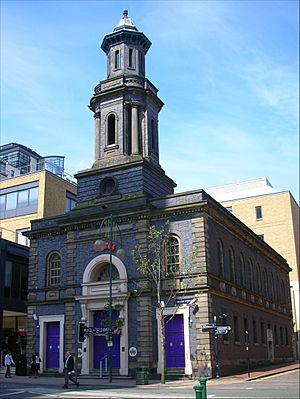Broad Street Presbyterian Church, Birmingham facts for kids
Quick facts for kids Broad Street Presbyterian Church |
|
|---|---|
 |
|
| 52°28′37.2″N 1°54′42.12″W / 52.477000°N 1.9117000°W | |
| OS grid reference | SP 06058 86584 |
| Location | Broad Street, Birmingham |
| Country | England |
| Denomination | Christian Scientist |
| Previous denomination | Presbyterian |
| Architecture | |
| Heritage designation | Grade II listed |
| Architect(s) | J.R. Botham |
| Groundbreaking | 1848 |
| Completed | 1849 |
The Broad Street Presbyterian Church is an old building in Birmingham, England. It is located on Broad Street. This building used to be a church for two different Christian groups. Today, it is recognized as a Grade II listed building, which means it has special historical importance and is protected.
The Church's Story
Building a New Church
The first stone for this church was put in place on July 24, 1848. A person named Charles Cowan, who was a Member of Parliament, helped with this important step. The church officially opened its doors in 1849. About ten years later, in 1859, some repairs and improvements were made to the building.
Changes Over Time
As the years went by, especially in the early 1900s, the church wasn't doing as well. In 1914, there was an idea to change the building into a movie theater. However, this plan did not happen.
Later, in 1929, another Christian group called the Second Church of Christ Scientist bought the building. They used it as their church for some time. After it stopped being a church, the building was used as a nightclub.
The Organ
Inside the church, there was once a large musical instrument called a pipe organ. This organ was made by a company named Brindley and Foster. You can find details about this specific organ in a special record called the National Pipe Organ Register.

